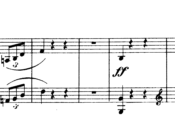Analysis
Contents
First Movement (Adagio)
Form: Binary Form. Eb Major.
PART I:
Bars 1-4: Melody in E flat major (tonic). There is a perfect cadence in the tonic, Bars 3-4.
Bars 4-8: A passage resembling a “Bridge” or “Transition” passage. After the perfect cadence, the following bars modulate on and end on an inverted cadence of F – quitted as the dominant in B flat major.
Bars 9-15: Second melody in B flat major (Dominant). This melody forms a regular second subject in the key of the dominant. There is an interrupted cadence, Bar 13, after which the previous two bars are repeated varied, ending the second time with a perfect cadence, Bar 15.
Bar 15: Half-bar’s link. This link modulates back to the key of E flat major and leads to the repetition of Part I, and then to Part II.
Double bar and repeat.
PART II:
Bars 16-26: Slight development of the first melody followed by the modulating passage modified so as to lead to the second melody in the key of the Tonic. The demisemiquaver (thirty-second) figures (Bars 20-21) are taken form those in the second melody, as also, by augmentation, are the semiquaver (sixteenth note) figures in the previous two bars. The inversion and re-inversion of the parts, Bars 18-20, should be noted. The remainder of Part II (i.e from Bars 22 to the Coda) is a repetition of the corresponding portion of Part I, with slightly variations and of course, the usual modification of key.
Bars 27-33: Second melody transposed into E flat major followed by the half-bar’s link.
Double bar and repeat.
Bars 34-46: Coda. The short coda which follows the double bar and repeat is reminiscent of the opening bars of the movement.
Second Movement (Menuetto)
Form: Minuet and Trio. Bb Major.
PART I:
Part I is in Ternary Form.
Bars 1-12: Part i: Sentence in B flat major (Tonic) modulating to F major (Dominant). Part i is an eight-bar phrase extended to twelve bars by repetitions in the second phrase. The first phrase ends on an inverted cadence in the tonic, Bar 4, the second on a perfect cadence in the dominant.
Bars 12-18: Part ii: Passage modulating back to B flat major. Part ii is a passage of six bars starting chromatically and modulating to the key of B flat major, in which it ends on a half-cadence, Bar 18.
Bars 18-32: Part iii: Repetition of Part i entirely in B flat major (Tonic). Note the inversion in the opening phrase (Bars 18-22); compare with the opening phrase in Part i. The after-phrase is slightly lengthened, and modified so as to end in the key of the tonic instead of the dominant.
Double bar and repeat.
PART II:
Part I is in Ternary Form.
Bars 1-8: Part i(a): Eight bars in E flat major (Tonic).
Bars 8-16: Part i(b): Eight bars in B flat major (Dominant).
The dividing of Part i is one of the features which marks the gradual evolution of the larger sonata-form out of the older and smaller form.
Double bar repeat.
Bars 16-24: Part ii: Passage containing slight development.
Bars 24-30: Part iii: Repetition of Part i with (a) and (b) both in the key of the Tonic.
Double bar and repeat.
PART III:
Menuetto I Da Capo.
Third Movement (Allegro)
Form: Sonata Form. Eb Major.
EXPOSITION:
Bars 1-8: First Subject in Tonic. The first subject consists of two four-bar phrases; it ends on a half-cadence in the tonic.
Bars 8-15: Bridge-passage or Transition. The transition modulates into the key of B flat major (the dominant), in which it ends on a half cadence, Bar 15; a half-bar’s link leads into the second subject.
Bars 16-39: Second Subject in B flat major (Dominant). The second subject consists of an eight-bar sentence (Bars 16-23) which is repeated, Bars 24-39, this time being varied and considerably lengthened by cadential repetitions. It should be noted that in Bars 30-31, an interrupted cadence replaces the original perfect cadence, and leads to the following cadential repetitions.
Double bar and repeat.
DEVELOPMENT:
Bars 39-61: The development refers to the first subject. Bars 43-47, starting with the chord of A flat minor and modulating to E flat major, are in sequence with the previous four bars in B flat minor and F minor. Note the inversion of parts in the following eight bars (Bras 47-55), which are worked on the opening motive and which, passing through the keys of A flat major and B flat minor to C minor. form a modulating sequence. Note also the Italian sixth in C minor, Bar 59. The music returns to the key of the tonic in the last bar of the section only (Bar 61), where the chord of the dominant in C minor (relative minor) resolves onto an inversion of the dominant seventh in E flat major.
RECAPITULATION:
Bars 61-69: First Subject Tonic (unaltered).
Bars 69-76: Bridge-passage or Transition (transposed into the key of the Tonic).
Bars 77-102: Second Subject in Tonic. There is no Coda; two extra bars are added at the end of the second subject to emphasize the final cadence.
Double bar and repeat.









